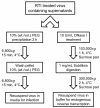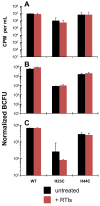Blocking premature reverse transcription fails to rescue the HIV-1 nucleocapsid-mutant replication defect
- PMID: 21682883
- PMCID: PMC3141651
- DOI: 10.1186/1742-4690-8-46
Blocking premature reverse transcription fails to rescue the HIV-1 nucleocapsid-mutant replication defect
Abstract
Background: The nucleocapsid (NC) protein of HIV-1 is critical for viral replication. Mutational analyses have demonstrated its involvement in viral assembly, genome packaging, budding, maturation, reverse transcription, and integration. We previously reported that two conservative NC mutations, His23Cys and His44Cys, cause premature reverse transcription such that mutant virions contain approximately 1,000-fold more DNA than wild-type virus, and are replication defective. In addition, both mutants show a specific defect in integration after infection.
Results: In the present study we investigated whether blocking premature reverse transcription would relieve the infectivity defects, which we successfully performed by transfecting proviral plasmids into cells cultured in the presence of high levels of reverse transcriptase inhibitors. After subsequent removal of the inhibitors, the resulting viruses showed no significant difference in single-round infective titer compared to viruses where premature reverse transcription did occur; there was no rescue of the infectivity defects in the NC mutants upon reverse transcriptase inhibitor treatment. Surprisingly, time-course endogenous reverse transcription assays demonstrated that the kinetics for both the NC mutants were essentially identical to wild-type when premature reverse transcription was blocked. In contrast, after infection of CD4+ HeLa cells, it was observed that while the prevention of premature reverse transcription in the NC mutants resulted in lower quantities of initial reverse transcripts, the kinetics of reverse transcription were not restored to that of untreated wild-type HIV-1.
Conclusions: Premature reverse transcription is not the cause of the replication defect but is an independent side-effect of the NC mutations.
Figures







Similar articles
-
Human immunodeficiency virus type 1 nucleocapsid zinc-finger mutations cause defects in reverse transcription and integration.Virology. 2006 Sep 15;353(1):41-51. doi: 10.1016/j.virol.2006.05.014. Epub 2006 Jun 19. Virology. 2006. PMID: 16784767
-
Mutations in human immunodeficiency virus type 1 nucleocapsid protein zinc fingers cause premature reverse transcription.J Virol. 2008 Oct;82(19):9318-28. doi: 10.1128/JVI.00583-08. Epub 2008 Jul 30. J Virol. 2008. PMID: 18667500 Free PMC article.
-
Cationic Residues of the HIV-1 Nucleocapsid Protein Enable DNA Condensation to Maintain Viral Core Particle Stability during Reverse Transcription.Viruses. 2024 May 29;16(6):872. doi: 10.3390/v16060872. Viruses. 2024. PMID: 38932164 Free PMC article.
-
When is it time for reverse transcription to start and go?Retrovirology. 2009 Mar 4;6:24. doi: 10.1186/1742-4690-6-24. Retrovirology. 2009. PMID: 19261185 Free PMC article. Review.
-
How HIV-1 Gag Manipulates Its Host Cell Proteins: A Focus on Interactors of the Nucleocapsid Domain.Viruses. 2020 Aug 13;12(8):888. doi: 10.3390/v12080888. Viruses. 2020. PMID: 32823718 Free PMC article. Review.
Cited by
-
Aromatic residue mutations reveal direct correlation between HIV-1 nucleocapsid protein's nucleic acid chaperone activity and retroviral replication.Virus Res. 2013 Feb;171(2):263-77. doi: 10.1016/j.virusres.2012.07.008. Epub 2012 Jul 16. Virus Res. 2013. PMID: 22814429 Free PMC article.
-
A protein ballet around the viral genome orchestrated by HIV-1 reverse transcriptase leads to an architectural switch: from nucleocapsid-condensed RNA to Vpr-bridged DNA.Virus Res. 2013 Feb;171(2):287-303. doi: 10.1016/j.virusres.2012.09.008. Epub 2012 Sep 24. Virus Res. 2013. PMID: 23017337 Free PMC article.
-
Quantitative microscopy of functional HIV post-entry complexes reveals association of replication with the viral capsid.Elife. 2014 Dec 17;3:e04114. doi: 10.7554/eLife.04114. Elife. 2014. PMID: 25517934 Free PMC article.
-
Sequence and structural determinants of human APOBEC3H deaminase and anti-HIV-1 activities.Retrovirology. 2015 Jan 22;12:3. doi: 10.1186/s12977-014-0130-8. Retrovirology. 2015. PMID: 25614027 Free PMC article.
References
-
- Levin JG, Guo J, Rouzina I, Musier-Forsyth K. Nucleic acid chaperone activity of HIV-1 nucleocapsid protein: Critical role in reverse transcription and molecular mechanism. Prog Nucleic Acid Res Mol Biol. 2005;80:217–286. - PubMed
Publication types
MeSH terms
Substances
Grants and funding
LinkOut - more resources
Full Text Sources
Research Materials

